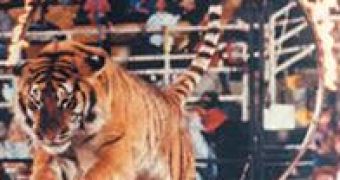Circus, in its modern meaning, has been employing both domestic and wild animals.
The horse was the first animal used in circus shows, whose canons emerged during the 18th century. Since then, the circus animals have been gradually increasing in number and variety. At the beginning, the trainers used animals that were easy and cheap to keep: dogs, cats, pigs, goats, crows, geese, pigeons and so on.
Later, the shows turned far-reaching, employing representations of over 12 horses of the same breed and color, elephants, bears and big cats, in increasingly large numbers. Combined training resulted in zoological "cocktails", like lions (or tigers) with horses, rhinoceros and tiger, and so on.
Today, we know that training is a learning process, based on conditioned reflexes. Any dog lover knows that each animal has an individual behavior and its training must be individualized. The same thing asked by the trainer will be learned differently by various animals.
The first differentiation is imposed by the fact whether the animal is domestic or wild. Training is more difficult and slow in the case of the wild animals, which must be tamed and accustomed to humans. A trainer will make 5 dogs occupy their pedestals much easier, more rapidly and without any danger, as compared to 5 lions. The same difference is between a representation with horses and zebras for executing the same classical movements.
No matter if the training method is gentle or tough, the animal is constrained to do something, but under various forms. An animal will know what to do (not to attack the trainer, not to lie down and so on); otherwise, it will experience a painful treatment or it will not receive what it enjoys much. Oppositely, when the animal conforms, it will not be punished and it will receive a good piece of food, a caress, or a praise.
In the past, large carnivores (bears and big cats) were trained using the force method, with cheap results, with high effect on the public. That was less than training. The animals were presented in relatively small cages, the famous "tamer" using the whip heavily, as well as the pitchfork and the blind bullets, basing his actions on knowing the "run distance" of each animal. Knowing this limit, even today some trainers can juggle, creating commercial effects.
The "gentle training" was founded by the dynasties Hagenbeck (Germany) and Durov (Russia). This is based on the saying "loves passes through the stomach". Today, trainers combine constraint with gentleness, depending on the character of the species, breed, individual and training number, but also on a subjective factor: the trainer itself.
The animals are often stimulated or corrected using the speech, the whip or special spurs or hooks (like in the case of the elephants), but sometimes the animals are heavily beaten or wounded through stinging, and these facts definitely represent cruelty. Even the gentle method of subduing the animal via hunger or underfeeding is no more "gentle". Many circus animals are, because of this kind of treatment, smaller than they should be.
Sometimes, surgical methods are applied: the claws of the bears and big cats are removed, as well as the canines of the carnivores and monkeys, to turn them less dangerous.
Some animals can be trained only based on permanent recompense, as pain stimulation cannot be applied with them (dolphins, sea lions, pelicans and others). But virtuosity numbers executed by elephants and bears are realized with a lot of patience and ... cruelty from the trainer and his/her helpers. Of course, cruelty must be masked in our days, and the trainer (who can be a sexy young woman) may have just a stick. However, the stick is made of steel and, skillfully handled, can cause pain to the bears. For elephants, small but sharp hooks are used, handled with discretion by the man that apparently caresses the animal. Electric whips are even more efficient.
Social animals are more easily trained than solitary species, as in their natural groups, they have a "chief" (alpha individual) than can be substituted or assimilated with the trainer. That's why a wolf may be easier to train than a jackal or fox. Bengal tigers are relatively easier to train than the solitary Siberian ones.
In the case of the snake numbers, employing boa or pythons, the snake is just "refrigerated" before the show. In this condition, the power and the speed of the animal are highly decreased, posing no danger for the trainer. In fact, reptiles are almost impossible to train; their brains are less developed than that of mammals, and learning is more difficult in their case.
And no matter how well are treated in the circus, the wild animals suffer enormously, much more than those kept in captivity in Zoos. The animals have very little space at their disposal in the mobile circus cages or menageries, where elephants and zebras are bound. To this, the continuous stress of the circus life adds, with its tours, when often, after the show ends, the tent is dismounted and all is loaded, transported to another city, reinstalled and another show follows. During the transportation, animals can experience excessive heat or cold, or lack of water.
Imagine a tiger built to roam thousands of square kilometers in the wild bearing a life on the few square meters of its cage, from which it goes out just for executing specific movements against its will, under the menace of the whip or pitchfork, in an imposed background, made of another species, the trainer, the public and so on. No wonder, one day, that constrained force unleashes and so many trainers ended tragically...

 14 DAY TRIAL //
14 DAY TRIAL //